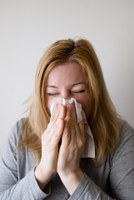Prairie Fare: New food allergen now listed on affected foods
(Click an image below to view a high-resolution image that can be downloaded)
“Are you ok?” my family asked.
We were in a restaurant, and I began sneezing continually. I couldn’t stop. I had ordered shrimp scampi.
My eyes were watering and my nose was stuffed. I think the other diners were wondering if I had a communicable disease. I practically ran to the restroom to blow my nose and try to stop my sneezing attack.
Fortunately, I got better. Perhaps someone at a nearby table had sprinkled a lot of pepper on the food. Pepper contains “piperine” that irritates the nose and causes sneezing as your body tries to get rid of it. Maybe the shrimp dish had some ground chili peppers, which contain “capsaicin” that can trigger sneezing.
I took my leftovers home. The next day at work, I had another sneezing attack right after finishing my shrimp dish. About 10 minutes later, I was OK.
What was the trigger to my sneezing? Had I developed a seafood allergy? Was a spice aggravating my sinuses? Did I just make it worse by triggering my immune system?
I am somewhat afraid of shrimp right now. Seafood allergies, like many others, can be deadly, but I have never reacted to it previously. I think a spice is the irritant.
Some allergens cause people’s skin to erupt in hives and sufferers may feel a tingling or itchy sensation around their mouth. Difficulty swallowing, breathing, tongue and lip swelling, and closing of the throat are hallmark signs of food allergy issues. Other people may cough or have digestive upset such as vomiting, diarrhea or cramps. Food allergies are very serious.
Anaphylaxis is the name of the worst-case scenario reaction to ingesting food allergens. An EpiPen can be lifesaving in the case of anaphylaxis, followed by a trip to the emergency room.
Unfortunately, food allergies cannot be cured. You need to avoid the foods that contain the allergen.
Let’s see what you know about food allergies.
1. At least how many different foods cause allergic reactions in sensitive individuals?
- 90
- 120
- 160
2. Name as many of the nine allergens required to be listed on food packages as you can.
3. What is the latest food allergen required on labels if it is present?
4. Which color additive must be listed on labels if it is present?
- Red No. 5
- Blue No. 2
- Yellow No. 5
5. Where must allergens appear if they are present?
- On the front of the package
- Under the ingredient statement
- On the Nutrition Facts label
6. Are advisory statements such as “produced in a facility that also processes (allergen)” required?
If you suspect you might have allergies or intolerances to foods, visit with a healthcare provider such as an allergist. You will need to approach food selection cautiously and read labels thoroughly, as well as asking questions at restaurants. These are the answers to the questions.
- C. At least 160 foods cause allergic responses.
- The nine food allergens are milk, eggs, fish, crustacean shellfish, tree nuts, peanuts, wheat, soybeans and sesame. The first eight items on this list account for 90% of allergenic responses.
- As of 2023, sesame is the latest food allergen required on labels.
- C. Yellow No. 5 must be listed by name if it is present.
- B. The allergen statement “Contains (allergen)” is found directly under the ingredient statement.
- No. Advisory statements that caution about other allergenic foods are not required on food labels. However, they alert people to the potential for cross-contact.
Check out the food allergen handouts and recipes available on the NDSU Extension website, along with the provided links for further information. See ndsu.ag/allergens for details. This is an example of a recipe from the series.
7-ingredient Chocolate Granola (Peanut free)
1½ cup unsweetened coconut flakes
½ cup pumpkin seeds
½ cup flaxseeds
1 tablespoon Sunbutter or almond butter
1 tablespoon canola oil
¼ cup dried cranberries
¼ cup semisweet chocolate chips
Mix together coconut flakes, pumpkin seeds and flaxseeds in a medium bowl; set aside. Heat a large-sized skillet over medium heat and add canola oil and Sunbutter or almond butter. Add the dry coconut flake/seed mixture to the skillet and stir well. Make sure dry ingredients are evenly coated with the butter mixture. Toast in the skillet for about 10 to 15 minutes on medium-low heat. Pour mixture onto a tray lined with parchment paper, and after a few minutes of cooling, add chocolate chips and dried cranberries and toss to mix. Chips will continue melting to make the granola creamy and chocolatey. Enjoy with milk, yogurt or by itself.
Makes 12 servings. Each serving has 160 calories, 12 grams (g) fat, 5 g protein, 11 g carbohydrate, 3 g fiber and 5 milligrams sodium.
(Julie Garden-Robinson, Ph.D., R.D., L.R.D., is a North Dakota State University Extension food and nutrition specialist and professor in the Department of Health, Nutrition and Exercise Sciences. Follow her on Twitter @jgardenrobinson)
NDSU Agriculture Communication – Feb. 9, 2023
Source: Julie Garden-Robinson, 701-231-7187, julie.garden-robinson@ndsu.edu
Editor: Elizabeth Cronin, 701-231-5391, elizabeth.cronin@ndsu.edu




